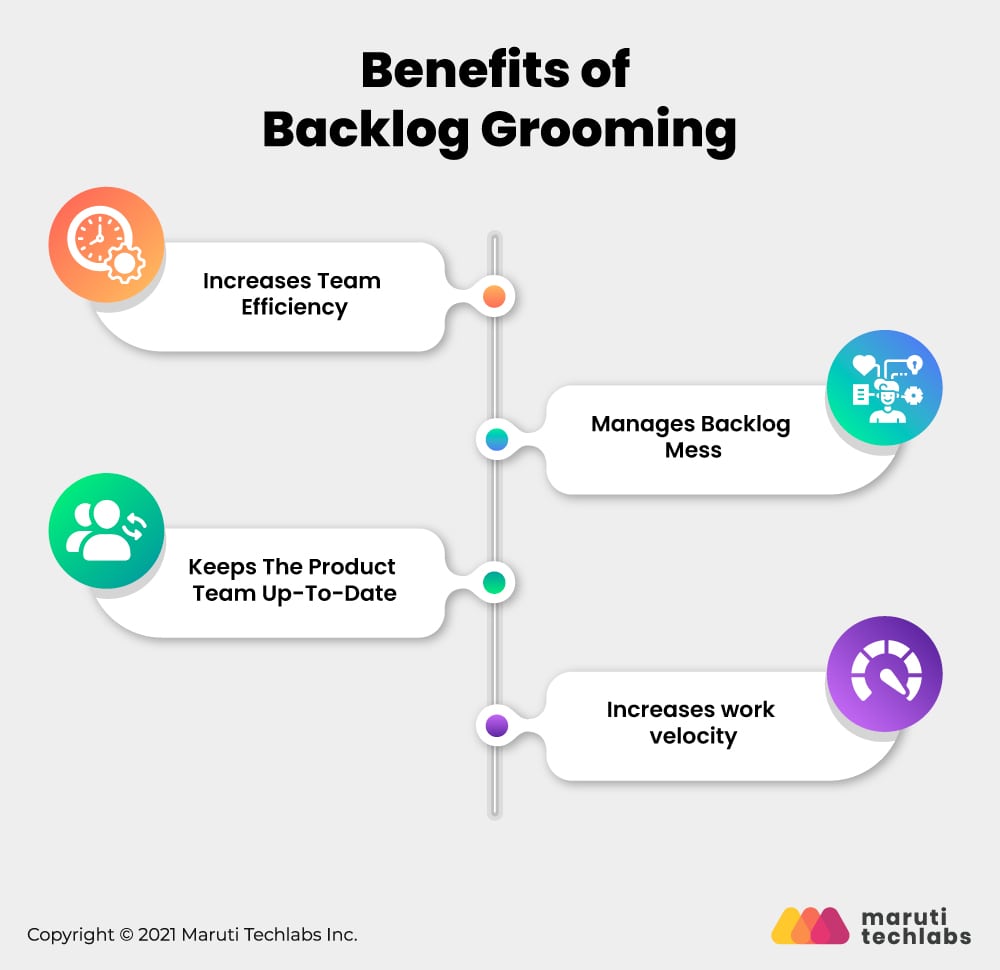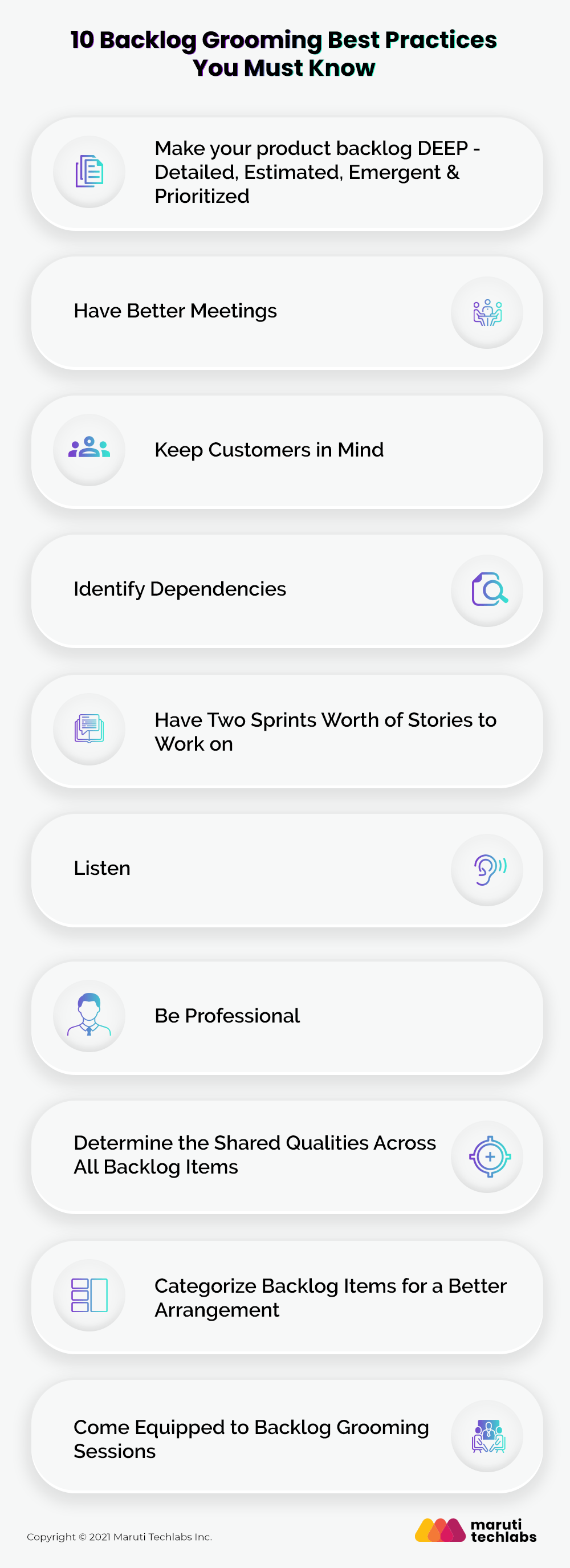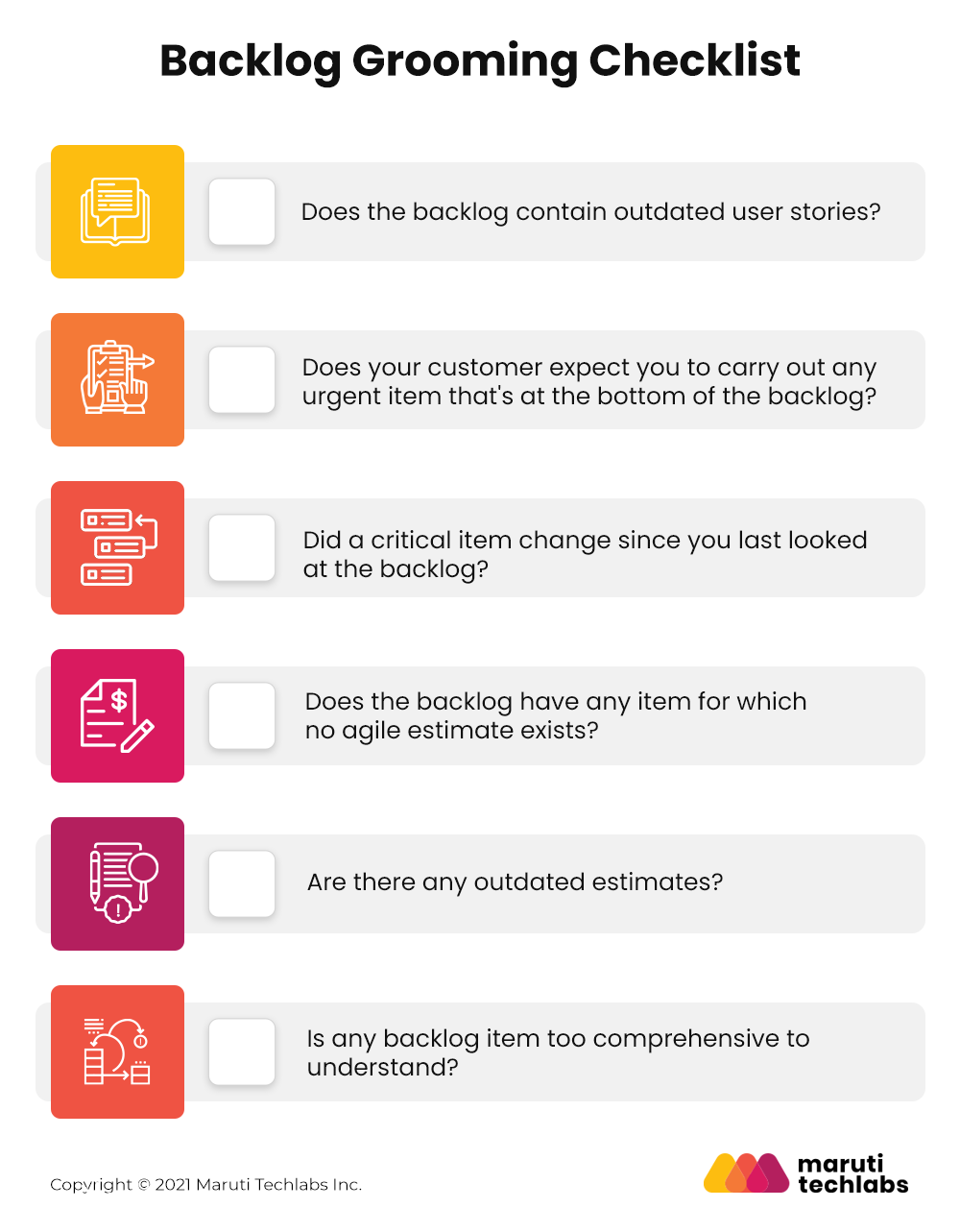

Agile Product Backlog Grooming: Key Steps and Benefits






Agile is all about continuous improvement, which means that your product backlog is always evolving. Your product backlog is a living, breathing thing. It’s constantly changing, growing, and evolving as you plan and build. Agile Product Backlog Grooming, also known as product backlog refinement, is an activity that helps you to improve your product backlog continuously.
Hey there! This blog is almost about 3000+ words long & not everyone likes to read that much.
We understand that.This is precisely why we made a podcast on the topic. Mitul Makadia, CEO & Founder of Maruti Techlabs, talks to Bikshita Bhattacharyya about his Agile implementation, strategy, and process during the nascent stages of the company.
He walks us through the challenges he faced, how the business benefited from scaling Agile, and how important is the scrum master in making Agile a success at the organizational level. Here is a small snippet from that episode. Check it out!
Product backlog refinement is one of the most critical meetings in an agile project. This is where one makes sure that the product backlog items are built. It’s the place where the product owner and the team collaborate to understand the requirements, estimate the product backlog items, and fill up the release.
Product Backlog grooming (also known as backlog refinement) is a recurring event or meeting where backlog items are reviewed and re-prioritized by product managers, product owners, and the rest of the team. The main objective of product backlog grooming is to keep the backlog up-to-date and ensure those backlog items are equipped for future sprints. Regular product backlog grooming sessions also provide that correct stories are prioritized and that the product backlog does not become a black hole.
Product Backlog refinement meetings are an excellent opportunity to explore progress with the products being worked on by a cross-functional team. In these meetings, product managers and product owners can easily explain the strategic purposes behind prioritized items in their backlog to help improve the alignment across groups.
Here are some activities that take place during product backlog grooming :
Some people feel that grooming backlogs once a sprint is essential for productivity. Hence, they remember what was decided from gathering all tasks for the next sprint! Other people are more relaxed about it and don’t want to spend a lot of time planning out every detail of their next sprint before they get started on it. However, if you find yourself in this position and care about improving the team’s efficiency, having a thorough grooming process allows everyone to better prepare themselves during the sprint.
Regularly grooming your backlog can prevent it from exploding.

There are various important reasons to adopt backlog refinement:
1. Increases Team Efficiency
The most significant way to motivate your team ahead of sprint planning is by grooming the backlog beforehand. This helps teams push forward continuously and increases the team’s overall efficiency. Product backlogs are there to help us handle our tasks more efficiently, helping us establish what we should be working on right now. That doesn’t mean backlogs need to be overthought – they simply need to give clear directions regarding what work needs to be done next and when.
2. Manages Backlog Mess
The backlog is constantly updated by the product manager, QA tester, developers, or other team members. This can cause a messy and chaotic backlog with many outdated items. Nothing gets done unless it’s on the backlog, but simply listing an item doesn’t guarantee that it will be accomplished. Product backlog refinement is the process of selecting which tasks are the most relevant to work on next – so you’re only working on what matters.
3. Keeps The Product Team Up-To-Date
Another advantage of backlog grooming is that it’s a way for everyone involved to stay informed about the status of different features and other aspects of the project at any given time. It’s a way to ensure transparency among all team members, ensuring they know what one another is working on instead of interrupting each other to constantly ask what’s going on. With a well-groomed backlog, no one has to re-explain their task because everyone already knows about it by heart: the fewer interruptions, the more productive the work.
4. Increases work velocity
A groomed backlog helps you not get overwhelmed by the number of incomplete tasks. It forces teams to deliver their product more rapidly and ensures the organization is moving forward on schedule. A well-groomed backlog reduces the time spent on planning sprints and increases the productivity of everyone involved in building the product.
Some other benefits include:
Typically, the product owner or product manager assists backlog refinement sessions. But this isn’t always the case. Depending on the organization’s hierarchical structure, the Scrum Master (in Agile Scrum teams), a project manager, or another team member may also lead these sessions.
The most important thing about identifying a Product Backlog Grooming facilitator is ensuring they have the right skills and experience to perform the role at hand. In other words, you’ll want to choose a person who can organize the grooming sessions and help keep them focused on achieving their larger purpose by doing things like preventing unnecessary digressions into trivial or off-topic topics. Moreover, the facilitator ensures that the sessions are regularly scheduled, the right people are invited, and follow-up communication is sent out to the team after the session concludes.
Not sure if you have the right team to handle your agile product backlog grooming? Consider hiring an expert agile development team to handle your regular product backlog grooming sessions while increasing efficiency and managing backlog mess.

There’s no hard-and-fast rule for who needs to attend a backlog grooming session. However, it is ideal that the entire cross-functional team is represented to have the most effective session. The combined expertise of the various individuals on your team is what you need to flesh out your user stories effectively.
A well-rounded grooming session should include:
Remember that while you want entire team representation, don’t invite too many people because they can slow things down. Requesting just a few key people is best because they will pitch in with ideas if and when needed.
While executive stakeholders may want to oversee progress, they usually do not need to be present during grooming meetings.
Product Backlog refinement meetings must be consistent. The consensus is that the ideal length for a backlog grooming session is between 45 minutes to an hour, depending on the team’s availability.
The best way to be efficient about grooming agile sessions is to keep things moving and ensure conversations don’t become sidetracked. Most teams decide that a project manager, Scrum master, or facilitator helps keep people on track during meetings. Some teams even decide to assign time limits to each user story to keep things moving.
There will constantly be a backlog, but not all items on that backlog are equivalent. Backlog grooming allows the manager to ensure appropriate items on their backlog list and listed in order of priority. Here are some handy tips or best practices required to maintain a healthy backlog.

Roman Pichler, the author of the book “Agile Product Management with Scrum,” used the acronym DEEP to summarize the essential traits of an effective product backlog.
The process of grooming the backlog is done during a meeting; therefore, it makes sense to maximize efficiency when conducting those meetings, only invite those who are most relevant at the time. Regarding input from non-essential members, get that information beforehand so as not to end up wasting everybody’s time in the first place!
Many ideas are thrown into the mix, as with every other team meeting. If you review your projected plan beforehand and make sure all members know their roles – this should be clear straight up. Make sure to keep things concise within an hour or two to avoid losing focus on what’s essential (and don’t let anyone’s topic dominate the conversation).
Backlog grooming must have a founding principle, and the foundation of all principles is the customer. When considering which stories to choose from your backlog, always remember that you’re eventually aiming to satisfy customers. The product is being created for customers, and hence, you should keep them in mind every step of the way.
Some tasks cannot begin until another dependent task is completed. These dependencies can halt team members and delay progress if not identified or managed. Make sure to identify any dependencies when backlog grooming.
During the grooming session, teams should have a backlog containing at least two sprints worth of work (i.e., not more than twice as much as they can realistically complete in an average sprint). This is because they have enough to keep them busy until it’s time for another grooming session and if priorities shift at any point.
While a plan with stated goals is critical to intelligent backlog grooming, that doesn’t mean it has to stay the same. The product owner must keep an open mind and listen to what others in their team say to make changes as required.
There will be different opinions about prioritizing and organizing the team during development. However, there is a joint commitment among the people involved to create the best product. They might disagree on how to do that. A product owner must keep this in mind and be professional towards all. Let everyone be heard and respected, but keep the team focused.
The Scrum Guide proposes a clear set of characteristics for your backlog items:
It may take some testing before you decide the best backlog item qualities to monitor; you don’t necessarily have to use the ones envisioned by scrum rulebooks. With a product management platform, you can constantly tailor your unique criteria and attributes to measure, prioritize and categorize items.
Some of the items and initiatives that could be logged in a product backlog include:
It’s essential to separate your development backlog from your product and insights backlog and make sure each item is marked accurately. This will not only keep your backlog less disordered but also accelerate your backlog grooming sessions.
Here are a few key things that everyone should review before a backlog grooming meeting:
Below We Have Some Tips to Help you Prioritize your Project Backlog.
Everyone wants to achieve their goals, but nothing gets done if you don’t take any action towards them. So, here’s a checklist that will help you track your progress and keep your backlog in check.

1. Have a conversation with more senior team members to detail backlog items or give estimates. Their input helps depth the understanding of your project’s direction and can support certain decisions you may contemplate.
2. Make sure you have the right people involved. Taking your entire team’s advice can be disruptive – it’s often better to involve those most informed and experienced in the matter.
3. Document your decisions to ensure they are repeatable. This is important and will pay off in due course. Human memory is unreliable, so over some time, you’ll be glad to see documented proof of a good or bad decision and will be able to measure the touchpoints with which an idea has played out.
4. Avoid excessively detailing your backlog.
5. You shouldn’t necessarily refine backlog items during the current sprint. You should think about refining the backlog for future items instead.
6. Don’t refine or polish the backlog of the current sprint until it ends, even if there is time left. You might feel tempted only to refine commitments to requirements right before they are due. That’s not a good idea, as that doesn’t leave room for potential gameplay that might increase or shift your product vision. Therefore, you might not deliver what’s expected.
7. Avoid disagreements on estimates and timelines. That’s usually an indication that refinement is lacking for that item.
8. When estimating stories in your backlog, it’s good practice to get more than one opinion. After all, this will help ensure you have a shared understanding of the effort and complexity involved in developing that particular feature. And sometimes, seeking multiple opinions also helps review assumptions or decide whether an estimate can be adjusted!
Did you find the video snippet on What were some improvements & iterations made while implementing agile in product development? to be insightful? We have a ~22 min video where Mitul Makadia gets into the weeds, and we discuss about Implementing & Scaling Agile to streamline Software Development. Take a look –
Consider comparing space missions with backlog refinement. The backlog is your mission guide. And unless you have a polished backlog, your mission guide will get you no further than the first page of your backlog. So, how do you create a refined backlog? We hope the backlog refinement tips shared in this blog helped you answer that question.
As we all know, backlog refinement is crucial in ensuring that your product backlog has everything it needs. When a product backlog is consistently updated during the sprint cycle, the team is more aware of what’s going on with the project. They also know when to stop – and when to continue. The clarity of your backlog will help keep morale high among development team members. They can trust that no sudden surprises wait for them around every corner without being informed beforehand.
We’re constantly working on adding more to our Agile Product Development series. Take a look at our other step-by-step guides such as –
We hope you enjoyed this detailed guide on Product Backlog Grooming. Backlog grooming can be tricky with many moving parts, but you can keep everything organized and on track if you follow the steps outlined in the blog. If you have any questions or want help with your backlog refinement process, don’t hesitate to contact us here. We’ll be happy to help out!
We have worked with hundreds of companies and helped refine their product backlogs in product management. Whether you are a start-up or an enterprise, get in touch with us for a free consultation and see how you can benefit from our product development services.


